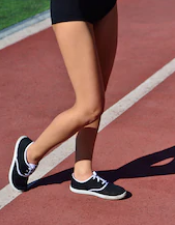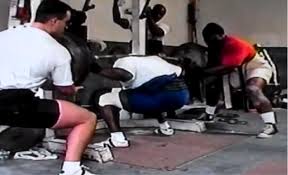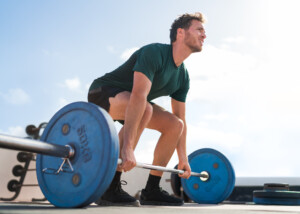
“Bad levers” are a freakin’ curse for the back squat and deadlift, whether you want to believe this or not.
I used to be a personal trainer for a health club. But even long before that, I knew that any kind of machinery or tool, like a wrench or bulldozer, is based on the physics of leverage.
Ironically, many muscle building enthusiasts continue to deny the significance of human body levers.
Ever had trouble untightening a bolt, but found it easy once you used a longer wrench?
You increased the force arm (“moment arm”) or the torque. This principle can be easily applied to a baseball bat. You’ll hit the ball a lot further using a long bat vs. a short bat.
Imagine building a teeter-totter. There’s a reason you’d place its fulcrum in the center.
Now put it close to one end, then put a rock down on the other (far) end. Push down on the short end; see if you can budge the rock.
Now put the rock on the short end; push down on the long end. Same weight to move, but it’s much easier when you’ve lengthened the force arm.
The laws of leverages apply to the design of construction and excavating equipment that moves hundreds of pounds of earth at a time.
The human body is a machine made of levers.
As a child, I always thought that strength came from only lots of big muscle and training.
But even the raging mother who’s lifting the car off her toddler will be at a big disadvantage if she has long femurs and short arms (though short arms are great for Olympic style lifting, combined with relatively short femurs).
Bad levers have nothing to do with ratio of fast twitch muscle fiber to slow twitch, nor the size of muscle fibers.
For example, imagine watching someone try to pick something really heavy off the ground.
This person is only five feet tall, but also has femurs that are SO long, that the shin bones are only five inches in length.
Though this is an unrealistic example of the human body, it proves a point.
By picturing this person trying to efficiently bend over to pick a heavy crate off the floor, you can now see how those abnormally long femurs get in the way.
Imagine this person trying to deadlift. Those doggone long femurs get in the way.
To reach the barbell, he or she must rely on significant trunk flexion, causing their legs to be almost straight, thus placing their lower back in a position for injury.
If they attempt to lift with more bent legs, say, a quarter squat, their long femurs set their hips further back, forcing them to lean over more, putting more stress on the lower spine!
If you’re having difficulty envisioning this, then elongate their femurs more and make their shins only five inches.
Now if they had long spider arms, this would help offset the long femurs.
Sometimes bad levers are due more to short shin length—relative to the overall body height.
If shins are shorter than femurs, this will put a person at a big disadvantage for the squat and deadlift unless they have a very long torso–relatively, of course.
I’ve seen people whose torsos were shorter than femurs, but were back-squatting beautifully (no gimmicks like sumo stance), because they had these super long shin bones acting like pedestals.
But the worst levers are when femurs are longer than the torso, AND also longer than the shins!

To pick something heavy off the floor, this individual must get into a very wide stance to protect their lower spine—unless they have crazy long arms.
Much of strength is determined by levers. This is why you might see a lanky person easily deadlift 285, while a muscle bound person of the same height struggles with it. LOOK AT THEIR LEVERS.
There are some exceptional freaks of nature such as champion powerlifter Steve Goggins, who has an excessive forward lean thanks to long femurs. But he’s so atypical.

Still skeptical about bad levers and weightlifting?
Before you lift a heavy item, you first get into the best position. Imagine if you were in a poor position, like standing further away from the barbell before you deadlift.
This will force you to bend over more as you pick up the barbell, causing the small stabilizing muscles in your low back to absorb forces it’s not supposed to.
But this is positioning simulates what a trainee with long femurs is forced to do.
If they get closer to the barbell and attempt the deadlift, their knees will get in the way–thanks to the long femurs (relatively, of course).
They avoid this by adjusting distance from the barbell — which is further out than someone with shorter femurs would have. Again, spider arms will help.
The long femur trainee with crummy pedestals and average torso and arm length (relative to overall height) will have to start a deadlift from virtually a half-squat position. This makes it harder.
Ever do rack pulls?
A rack pull is a deadlift done inside the cage; safety bars stop the barbell at some point between the knees and lower shins.
Thus, your bottom position has you pretty upright; why you can rack pull a lot more than deadlift.
For a person with bad levers, their bottom position in a rack pull would be quite similar to the bottom position that a trainee with good levers would have for a deadlift!
So if a bad-lever trainee can rack pull 225 pounds for reps, but can deadlift only 185 for reps, it’s safe to assume that if this individual had good levers, he or she would be able to deadlift 225 pounds for reps!
Though the long-femured (and short-shinned) athlete with average arm length (let alone T-rex arms) will have to strain more to lift up heavy things off the ground due to inefficient positioning, and will need to work much harder to master the back squat, at least we can agree that trainees with long femurs have an advantage in executing martial arts kicks.
 Lorra Garrick is a former personal trainer certified through the American Council on Exercise. At Bally Total Fitness she trained women and men of all ages for fat loss, muscle building, fitness and improved health.
Lorra Garrick is a former personal trainer certified through the American Council on Exercise. At Bally Total Fitness she trained women and men of all ages for fat loss, muscle building, fitness and improved health.
.








































